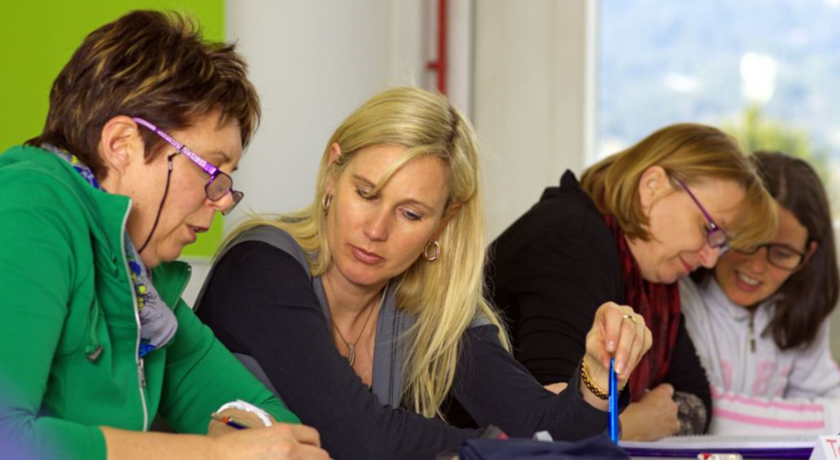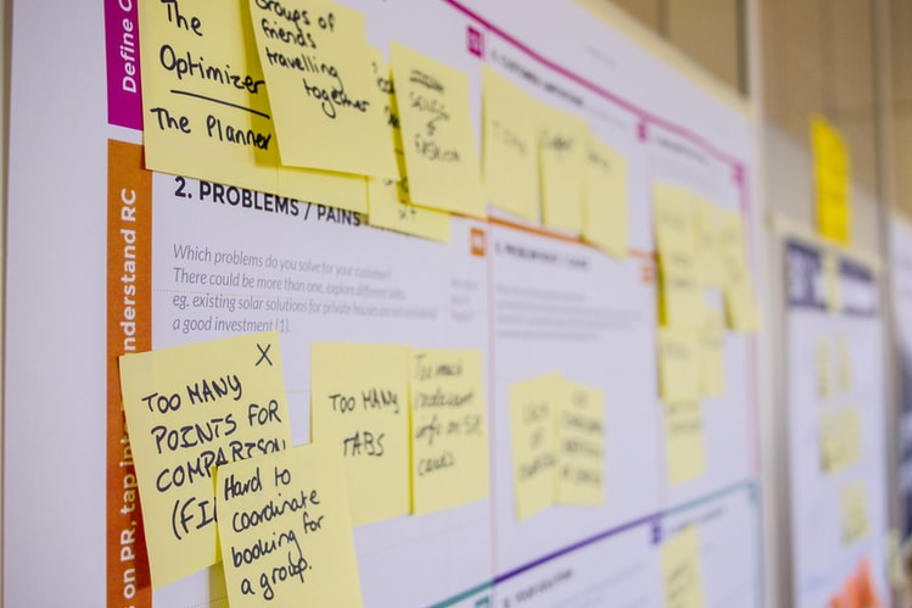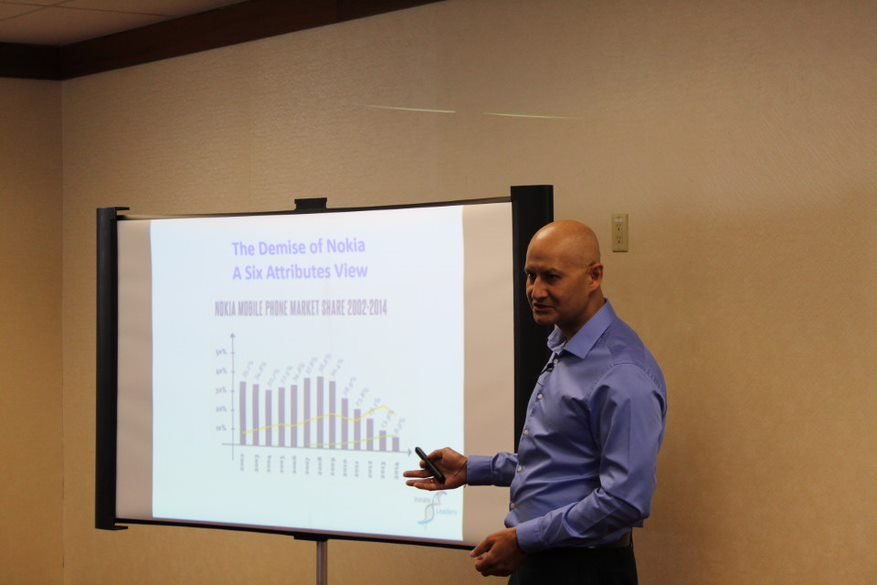3 Pro Tips on Using D.I.S.C. in Your Office
Professional facilitator, Lyndon Friesen, offers expert advice on how your team can effectively use D.I.S.C. within your organization. Find out the three business situations he recommends using D.I.S.C. in to become a stronger, more cohesive team.
Identifying your team’s strengths and weakness is great…but can having this knowledge really help with everyday interactions in your office?
Our team recently sat down with Lyndon Friesen, Lead Skill Development Facilitator at Outback Team Building & Training, to discuss the best ways to use D.I.S.C. in the workplace.
In the interview, Lyndon suggests that the self-assessment tool can be used in a variety of ways, such as during:
- Meetings & Projects
- Conflict Resolution
- Performance Management
Listen to the episode of Outback Talks: The Employee Engagement Podcast below to hear directly from Lyndon, or keep reading for practical advice on how you and your colleagues can use D.I.S.C. in the workplace.
3 Business Situations to Use D.I.S.C. In
When and how can you actually benefit from D.I.S.C assessments during your workday? Here are three situations that Lyndon recommends using D.I.S.C. in to help improve how your team works together.
Meetings & Projects
Does it feel like your meetings and projects never go anywhere? D.I.S.C. can help you manage more productive strategy sessions, team briefs, and group tasks. Equipped with the knowledge that not everyone works in the same way, your team can make better use of colleagues’ strengths during these types of meetings and projects.
In a brainstorming session, for example, you’ll be able to source different, complementary opinions. You will also be more aware that just because someone isn’t asserting their ideas, doesn’t mean they don’t have any.
Understanding the different profiles can also help you put together a more rounded team for a project, and embrace the differences in how you work.
“In a perfect world,” says Lyndon, “somebody who is high in Conscientiousness, when they’re assembling their own mini team to work on a project, would actually go after somebody who is high in ‘D’…who is results-orientated.”
Conflict Resolution
No one enjoys conflict. But, in most organizations, it can be a difficult thing to avoid all together. Lyndon suggests, however, that once teams know their colleagues’ profiles, conflict can become a positive opportunity.
If you understand where someone is coming from, it can be easier to embrace differences, such as communication styles and perceived work ethic.
“When you see a team not avoiding each other and working with each other, they’re actually embracing that we are different, and that we’re bringing different things to the table,” says Lyndon. “That’s exciting!”
Not sure where to start? Learn how to turn a negative clash into something positive with a Conflict Resolution training program.
Performance Management
If you’re a manager, knowing your team’s D.I.S.C. profiles, as well as your own, can help you provide more constructive and effective feedback.
Before offering positive encouragement, negative feedback, or a general performance review, think about the individual you will be speaking with.
For example, if you rank high on Influence but your team member leans towards Conscientiousness, you may want to give feedback in a private setting and provide data to back up any points. This most likely would differ from your initial instinct to give praise publicly, or offer feedback – good or bad – with enthusiasm.
“Understanding ourselves and understanding our teammates is critical,” says Lyndon.
Learn More About D.I.S.C. in the Workplace
You can also download A Practical Guide to Using D.I.S.C. in the Workplace for more tips from Lyndon Friesen, including step-by-step advice on introducing D.I.S.C. within your organization. Simply click the button below for access to your free copy of this all-in-one PDF document.
Don’t forget, you can also tune into Lyndon’s interview above, or download the episode by subscribing to our podcast, Outback Talks: The Employee Engagement Podcast, on iTunes, Google Play, SoundCloud, Stitcher, or wherever you listen to your podcasts.
If you’d prefer to read Lyndon’s interview, see below for the full transcription of the podcast episode.
Kara Sy (KS): Hi everyone, and welcome to “Outback Team Building & Training Tips,” a monthly audio resource for HR and business professionals. This podcast is produced by Outback Team Building & Training, a leading team building, training, and consulting provider for organizations across North America. I’m your host, Kara Sy, and this month I’m joined by special guest Lyndon Friesen, Lead Facilitator of Outback Team Building & Training’s skill development programs. Thanks so much for joining me today, Lyndon!
Lyndon Friesen (LF): Thank you for having me.
KS: Our topic this month is how to practically use D.I.S.C. assessments in the workplace, and Lyndon will be sharing his insight and experience on the topic. But, before we begin, let’s start out with our quick tip of the month. Each month we begin the episode with a quick tip for our listeners. Lyndon, what’s the number one benefit of doing D.I.S.C. assessments with your team?
LF: One of the biggest things that companies are looking for is how their teams are going to work more effectively together, and a tool like D.I.S.C. gives people the opportunity to become more self-aware of who they are within a team dynamic, thereby allowing themselves to work more effectively together.
KS: Great! Okay, so with that, let’s get to our main interview. Alright Lyndon, so, for people who may not know, what does D.I.S.C. stand for?
LF: D.I.S.C. stands for four things. One is Dominance, two is Influence, three is Steadiness, and four is Conscientiousness.
KS: Okay, and so, why do you think they put it into an abbreviation like that? Is it just easier for people to remember in the acronym?
LF: I think that’s all it is. Acronyms have a way of being – becoming more sticky for people, and these four words are kind of their core quadrants that they use on their assessment tool.
KS: Okay, so, can you explain each of those four for us?
LF: Dominance is how much emphasis one places on results and the bottom line, and it’s an outward reflection of someone’s confidence.
KS: Okay, so maybe a bit more, to someone who isn’t a “D,” maybe comes across a bit more aggressive?
LF: They would be viewed as either aggressive or very assertive.
KS: Okay, what about “I”?
LF: “I” references a person’s emphasis on influencing or persuading other people and relationships.
KS: Okay, and “S”?
LF: “S” is reference to steadiness, and it’s emphasis on cooperation, sincerity, and dependability.
KS: And “C”?
LF: “C” is conscientiousness, and it’s a person’s emphasis on quality, accuracy, expertise, and competency.
KS: And so, these are the main qualities that someone would exhibit in a workplace?
LF: There are four quadrants that they’ve identified, and within each quadrant there are some aspects to a person’s personality…
KS: Right.
LF: …that deals a little deeper beyond just dominance.
KS: Right, and so how is one assessed in these four quadrants? How do you figure out if you’re a “D” versus a “C”?
LF: Yes, you see, you complete an online assessment form and you get a report back that assigns a dot within a circle that would fall somewhere within the four quadrants. Either Dominance, Influence, Steadiness, or Conscientiousness.
KS: And so, technically, you can be a combination of all four, or you are a combination of all four.
LF: I think that’s what it is – you’re correct, Kara – that most people think that if they fall under, you know, Steadiness, that they have nothing as to a place on Conscientiousness or Dominance, and that’s not true. It just means that there’s a gravitational pull that you have to operate within that quadrant.
KS: Right, and so, are you’re kind of looking at it, like, where you would be plotted on a graph. Say, so, you’re more towards being an “I” but you’re a little bit close to the “C.”
LF: Absolutely, yes, and it’s your comfort level in working with people who are more similar to you. So, for example, somebody who’s high in Conscientiousness, which is quality and accuracy, might have conflict with somebody who is high in Dominance, because somebody who is high in quality places a preference on getting it right, and someone who is high in Dominance has a preference for getting the result. And often, those two, for example, could be in conflict with each other.
KS: Sure, and so the person who is seen as a “D” might think of a person who’s seeing as an “S” as not caring about reaching those goals, where in reality, they just care about reaching that goal in a manner that has quality.
LF: Absolutely. I think they’re both after the same thing, but they’re coming at it in two different ways.
KS: Right, and so, you mentioned the online quiz, the assessment. Is that the best way for someone to figure out where they land on the D.I.S.C. profiles?
LF: Yes, it is. It’s the starting point.
KS: Okay.
LF: And so, if you get the assessment form and you look at where you’re at, and you kind of keep that information to yourself, meaning, you’ve taken the assessment online in isolation of other people, you’re probably not going to, you know, get a lot of benefit from it. So, the benefit comes when you do it with other people who are within the team dynamic at work.
KS: Right, and so, how do you recommend doing that? What’s the next step after taking the online quiz?
LF: The next step after that would be – so, one would be to do it within the context of the team that you’re in, and then two would be to actually have somebody help you unpack the learning.
KS: Someone like yourself?
LF: Someone like myself. And then, really, the biggest benefit is when you start to come up with practical ideas to breathe life into the different assessment profiles that different people have.
KS: Right. And so, as a third-party facilitator, how important do you think it is that the person leading the session with the team who’s done their assessments is not part of that team? Do you think it’s important to open up someone’s perspective on what it could be like to work well with other D.I.S.C. profiles?
LF: I think, anytime you get an outside perspective, it could really help. Somebody who’s knowledgeable in the field, somebody who understands what the actual dot means within the graph or chart, and then allows you to begin to see how – where your teammates are, and gives understanding as to why somebody might react one way to situation and you might react very differently. Though, it’s actually not a conflict, but we perceive it to be a conflict.
KS: Right, so, using your further understanding of where someone falls on the D.I.S.C. profile to help you have a better working relationship.
LF: Absolutely. So, step one is be aware that if you’re highly dominant, that there’s a real plus to that, but there can be a downside to it too. Or, if you’re a, you know, high on conscientiousness, that there’s a real plus to that, but there’s a downside to it too. So, to become a better team member, we have to first become more aware of who we are and the plus of the strength, but there’s also often a downside to that strength, and then be aware of our teammates and where are they on the D.I.S.C. assessment…
KS: …where they fall.
LF: Where they fall.
KS: Yeah, and then, understanding how someone that you saw as being aggressive before then discovering that they’re – they have this dominate profile can actually help you see the benefits to that. You might then be able to work around previous conflicts because now you better understand where they’re coming from.
LF: If we fast forward – I think you’re absolutely right, Kara. If we fast forward to three months later, in a perfect world, within a team, somebody who is high on conscientiousness, when they’re assembling their own mini team to work on a project, they would actually go after somebody who is high in “D”…
KS: Right.
LF: …who is very different than them because they would go, “Thank goodness I have somebody who is results-orientated on my team to compliment me.” So, instead of that being, you know, friction-driven differences, were actually embracing the differences together.
KS: Yeah, so my next question was actually going to be about how understanding colleagues’ D.I.S.C. profiles can help you work better together, but I think we’ve just covered that. I think, just understanding how their strengths can help you in your weaknesses, can help you work better together as a team. And seeing that as a plus, rather than a negative, rather than a reason for conflict, a reason to move forward together and collaborate.
LF: Yeah. I think when you see a team not avoiding each other and working with each other, they’re actually embracing it because we are different, we’re bringing different things to the table. That’s exciting!
KS: Yeah. And do you have any examples, having worked with companies and helped them better understand D.I.S.C. profiles, are there some examples that you can give us that you’ve seen them take away?
LF: In terms of – I often will say, after the work that I do with the client, the real work begins, which is bringing it to life. And so, a lot of these different assessment programs, people leave and they feel great, but you ask them three months later, did it make a difference? And a lot of them say no, and it’s because they haven’t come up with a plan to bring life into it after the session’s done. And so, there’s a lot of different ideas that I work with clients on that help do that, and here is a couple of them: one is, some companies create a coffee date concept where they have to take somebody out for coffee that’s in a very different profile than they’re in.
KS: Oh, that’s really interesting.
LF: And they’re going to record it, and part of that time that they’re having coffee with this other person is to get to know them a bit better and understand why they’re driven in certain way, what motivates them, and learn to embrace each other versus fight each other.
KS: Yeah.
LF: Another one is an organization that painted a huge wall with the D.I.S.C. quadrants on it, and with an erasable marker people would actually put their dot on the wall as a visible reminder every day that we’re different and we’re to embrace our differences, not fight our differences, and to be public about it. There are lots of people who take this assessment and believe that there’s this ideal profile to have, ideal placement of the dot, somewhere in the quadrants – and there is no ideal place.
KS: No, of course not.
LF: There is your place and that’s the right place. And it’s more awareness of where that dot is in relationship to your teammates.
KS: Right.
LF: Some people have a “Name Tag Day,” which they do different color coordination of. Let’s say, all the “Ds” wear a name tag one day and it’s a red name tag, and it’s just an awareness of those “Ds” in our company. “Let’s celebrate the Ds in our company.” So, there’s a lot of different creative ideas people come up with that I will work with them on to help bring it to life after the session is done.
KS: Yeah, and I think the – some of these examples that you’ve provided, these are really great practical ways that people can keep D.I.S.C. assessments top of mind for their employees. It will remind them, like you said, after the session’s over, the work is just beginning, and it’s not going to benefit anyone if they don’t remember that they’ve done these assessments.
LF: Yes.
KS: And that everyone is different and it’s great that everyone’s different, and that they can work better together if they understand and keep these things top of mind.
LF: Right.
KS: Yeah. So, do you have any final tips for us?
LF: I think, maybe the final tip is building off what we have just talked about, which is, somebody has to lead the charge after the session is done. And leading the charge just means, how will we implement this in a practical way and continue to give visibility to the work that we’ve just done. We started with this idea that self-awareness allows change to happen. And so, the practical ways of bringing it to life are just to give people enhanced self-awareness of, “Right, we did cover that off, and this is my responsibility to work with people who think differently than I do.” And it’s to have a champion within your company.
KS: The advocate who keeps promoting the D.I.S.C. profile.
LF: Who keeps it visible and keeps promoting it.
KS: Yeah, and I guess you can use it, you know, in other ways throughout the company. Like in recruitment, for example, you could use it to try and find the missing piece to your team’s puzzle. Or, like you’ve said, for conflict resolution, and I’m sure it would be beneficial, in a feedback session.
LF: I think it’s important, if you think of recruitment, and if one of the teams you had were filled with, you know, a bunch of people that were strong in one of the quadrants but missing in another quadrant, it would be – we need to identify somebody that might actually complement us, versus be the same as us.
KS: Right, yeah, exactly.
LF: So, as it relates to the team, you want to have representation in all four quadrants.
KS: Yeah, and for feedback and reviews, for example, it would be beneficial for a manager to understand the person they are reviewing what their profile is, correct?
LF: It is, you’re right. From recruitment to performance management of an individual, to how we deal with conflict, to how we build effective team dynamics, understanding ourselves and understanding our teammates is critical for that.
KS: So you can, basically, weave D.I.S.C. assessments throughout your entire organization, through all the different facets of your company.
LF: So, the work that we do with D.I.S.C. is often a platform to give context into one of the other skill development topics that we work with clients on, including conflict, team dynamics, emotional intelligence. It does weave itself into all the different topics that we cover.
KS: Yeah, well that makes a lot of sense. Thanks so much for joining me today, Lyndon. That’s it for this episode of Outback Team Building & Training Tips. Outback Team Building & Training helps organizations across North America build relationships through memorable team building, training, and consulting experiences, and our team has been recommended by over 14,000 corporate groups in the United States and Canada. For more tips and expert advice on improving employee engagement, visit the Downloadable Resources section of our website at outbackteambuilding.com to download your free copy of “A Practical Guide to using D.I.S.C. in the Workplace.” And don’t forget to subscribe to our podcast on iTunes, Google Play, Stitcher, or wherever you may listen to your podcast. Until next time! Thank you for listening.





Comments